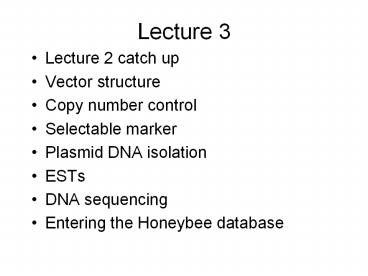Lecture 2 catch up - PowerPoint PPT Presentation
Title:
Lecture 2 catch up
Description:
Lecture 3 Lecture 2 catch up Vector structure Copy number control Selectable marker Plasmid DNA isolation ESTs DNA sequencing Entering the Honeybee database – PowerPoint PPT presentation
Number of Views:106
Avg rating:3.0/5.0
Title: Lecture 2 catch up
1
Lecture 3
- Lecture 2 catch up
- Vector structure
- Copy number control
- Selectable marker
- Plasmid DNA isolation
- ESTs
- DNA sequencing
- Entering the Honeybee database
2
How are different sizes of DNA strands separated
on agarose gel?
Mixture of DNA molecules
3
DNA separation is based on fragment size
4
Size markers and their use to determine size
5
Size markers and their use to determine size
Mobility of a DNA fragment is proportional to
the log of its size in bases.
6
Plot of relative mobility of DNA vs log of size
on semi-log graph paper
7
Varying concentrations of agarose
How does one make a 0.7, 1.0 1.5 agarose
gel? Why are there varying concentrations of
agarose gels?
8
Varying concentrations of agarose
Why are there varying concentrations of agarose
gels? Higher concentrations provide better
resolution for smaller DNA fragments Lower
concentrations provide better resolution for
larger DNA fragments
9
Experiment 1What is an EST?
10
pT7T3-pac
11
3 important parts of a vector
- Origin of replication
- Selectable marker
- Cloning sites
12
(No Transcript)
13
Origin of replication considerations
- What is an origin of replication?
- Why do we need one?
- What properties should it have for easy plasmid
DNA isolation?
14
Replicon Contains all info necessary to begin
and end DNA replication Origin of replication
(Ori) is a defined location within the replicon
where DNA synthesis begins
15
The ColE1 origin of replication
16
ColE1 origin
- RNAII forms the primer for initiation of DNA
synthesis - RNAI and Rop protein are negative regulatory
functions RNAI binds to RNAII stopping primer
formation Rop protein stabilizes the complex
formed by RNAI and RNAII.
17
The ColE1 origin of replication
18
RNAIRNAII interaction
19
Rop protein negatively regulates the origin of
replication by stabilizing the RNAIRNAII
interaction.
20
Copy number
21
Why does pT7T3.pac have a high copy number?
- Point mutation in the origin that alters the
initiation of RNAI transcription, such that the
RNAIRNAII complex does not form as well as
wild-type. - The region of the origin that encodes Rop protein
is deleted.
22
Selectable Marker
- Ampicillin resistance
- Ampicillin is a penicillin derivative.
- Blocks cross linking of the bacterial cell wall
causing the cells to burst/lyse. - Ampicillin resistance gene encodes a secreted
enzyme that cleaves the beta-lactam ring.
23
Benzyl penicillin
b-lactam ring
24
Mechanism of resistance
25
Plasmid DNA isolation
- Separate chromosomal DNA from plasmid DNA
- Remove protein
- Remove RNA
- Easy
26
Starting material
27
Lysis and denaturation
28
Neutralization and centrifugation
29
Column
- Silica gel
- DNA binds at high salt.
- DNA is eluted at low salt.
- Removes glycogen and other cellular components.
30
(No Transcript)
31
ESTs
- Expressed sequence tags?
- What are they?
- What do they represent?
- What do we use them for?
- What are their advantages?
32
How is cDNA made?
First strand synthesis
GCGGCCGCGTTGCTTTTTTTTTTTTTT 3
3 AAAAAAAAAAAAAAAAAAANNNNNNNNNNNN
Reverse transcriptase
33
Second strand synthesis
Remove mRNA with OH or enzymatically
DNA polymerase I
Cut hairpin
Add EcoRI adaptors GAATTCGGCACGAGG
Cut with NotI and insert into EcoRI NotI of vector
34
Normalized Library
mRNAs accumulate to different levels in a mRNA
sample. Normalization is a method of evening out
the abundance levels using hybridization.
35
T7 sequencing primer?
36
DNA SEQUENCING
Dideoxy or Chain Termination Method
1974 Maxam/Gilbert (USA) (Chemical
Cleavage protocol) Sanger (England) (natural
process of DNA replication)
37
Sanger Sequencing in 1989
38
(No Transcript)
39
Example output
40
Why is the size of the insert important?
- A sequencing run may only go 500-700 bases.
- What might you see and what might you not see?
41
EST gel
42
Clipping an EST sequence
- What are we clipping out?
- Why do we look for GAATTCGGCACGAGG and
GCAACGCGGCCGC? - Why do we look for AAAAAAn?
43
Example
- GAATTCGGCACGAGG
- CGCGTTCTTGAAAAGACAGGTAAAATGCGAGTTCCAGAATGGGTAGAATT
GTAAAGTCTGCACGATTCAAGGAACTTGCTCCATATGATCCAGATTGGTA
TTATATTAGATGTGCTGCTTTAGTTCGTCATATTTATATTCGAAGTCCAA
TTGGTGTTGGAGCAGTAACAAAAATTTTTGGAGGACGCAAACGTAATGGT
ACTCATCCTAGCCATTTCTGTCGATCGGCAGGTGGTGTTGCTCGCAAAGC
TCTTCAGAGCTTGGAACAACTTAAACTCATTGAAAAATCTCCAGTTGGTG
GACGTAAACTTACCAGTCAAGGCCGTAGAGATTTAGATCGCATTGCTGCC
CAAGTCAAAGCAAAAAGCAAAAAACAACTTAAGTTACAAGAAACTCTTGT
TCTCTAATTTCTTTATTTCTATAATAAAAATTAAAAAATCGTACATTTAT
ATTCAAATTTTATTTATTCTACTATTATAAGTTAATTTTAGAAGTCTTAA
ATAATTTAATGGTAACAAAATATCACAAGACAATGTGCTATTATTTTTTT
AATTGTTTATGAATTATCATAATTGAGGAAATTTTTAACTATAAATAGAT
AAAGTAAGAAATATAAATTTATAATTTATGATTATGTATTTTATATCTAA
ATGTATTTATTAATCTAAATATAAACAAATATACAT - AAAAAAAAAAAAAAAAAAAAAAAA
- GCAACGCGGCCGC
- AAGCTTATTCCCTTTAGTGAGGGTTAATTTTAGCTTGGCACTGGCCGTCG
TTTTACAACGTCGTGACTGGGAAAACCCTGGCGTTACCCAACTTAATCGC
CTTGCAGCACATCCCCCTTTC
44
Example output
45
What could go wrong
- 18 of ESTs are in the reverse orientation.
- Potential of 2 inserts in the clone.
- What would this look like?
46
Step into liquid
47
Clipping a sequence I
48
Clipping Sequence II
49
Clipping Sequence III
50
Clipping Sequence IV
51
Step into liquid































